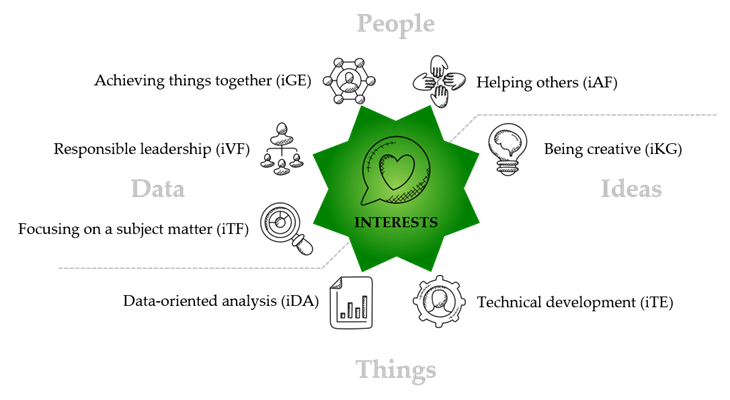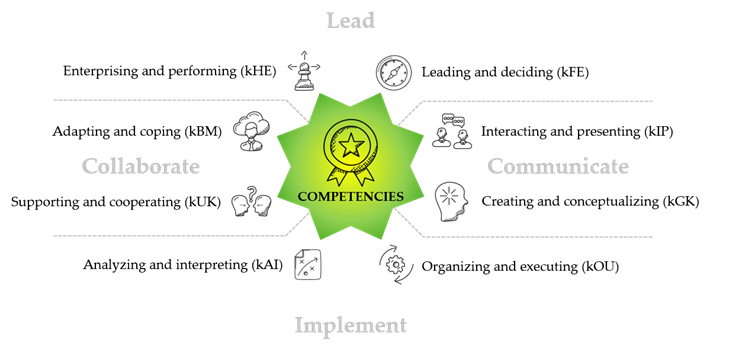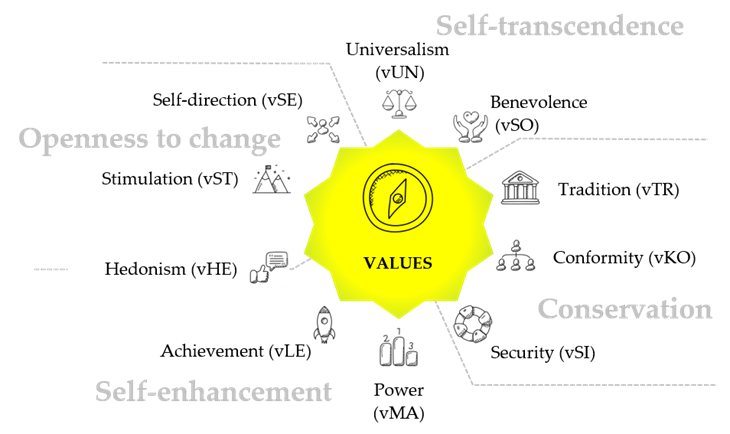The Key Dimensions of the Career Profiler
At the core of our study are the three dimensions of work-related interests, competences, and values.
Interests refers to a topic area entitled “What do I want?” It includes questions such as "What drives me?", "What activities do I enjoy?" and "What occupations energize me and motivate me to cope with other activities?" Work is “doing” - planning a professional career requires us to determine a portfolio of activities that will be enjoyable. This is where our reflections begin. . Find out more about the concept used
Competences refers to a topic area entitled “What do I care about?” It includes questions such as "What am I capable of?", "What skills do I employ to address the challenges I’m confronted with?" and "Where are my limitations?" Work is “demonstrated ability” - a promising plan for a professional career is related to the self-efficacy we experience. This is where our reflections continue. Find out more about the concept used
Values addresses the topic area related to “What environment am I looking for?” It includes questions such as "What basic assumptions do I make or avoid?", "What beliefs do I hold?" and "What do I want my work environment to be like?" Work is “social interaction” – an effective plan for a professional career must reflect purpose, belonging, and teamwork as the basis for collaboration. Find out more about the concept used
The Concepts Operationalized in the Career Profiler
To enable users to reflect on their work-related interests, a separate measuring instrument was developed. Its concept is based on elements of the Personal Globe Inventory (PGI)[1]. The PGI is particularly suitable because it generally refers to a somewhat broader range of activities than can be found in operational administrative positions. For example, in addition to traditional administrative activities such as data-oriented analysis or expert tasks in a specialist field, it also maps activities carried out in nature or related to mechanics and technology, or design. It is important, especially in this subject area, which is always identified first in the study, that the horizon of possible career options is not too narrow. The survey uses a simplified version of the PGI and takes eight activity-related factors into account: joint achievement, responsible leadership, thematic focusing, data-oriented analysis, engineering, discovering nature, creative design, and promoting others. The model divides these activities into four quadrants, depending on whether the activities relate more to things people, data, or ideas Find out more about the interest factors and related items.

To enable users to reflect on their work-related skills, the measuring instrument builds on the Great Eight (GE) [2] model. The GE model deliberately focuses on skills associated with the performance of employees in business environments. Eight dyadic factors are taken into account, which together result in a skills profile: analysing and interpreting, designing and conceptualising, managing change and mastering challenges, supporting and cooperating, interacting and presenting, leading and deciding, organising and implementing, entrepreneurial action and achieving goals. While these factors were not originally categorized by the model’s creators, they were divided into four groups for the purpose of this study: skills to lead, communicate, achieve, and collaborate. Find out more about the competence factors and related items.

To enable users to reflect on their work-related values, the measuring instrument builds on the Schwartz Value Survey (SVS) model [3]. While the SVS was not originally developed with the workplace in mind, it has been adapted for this study. With its 10 factors, the SVS forms a balanced and sufficiently comprehensive model for collecting a value profile of participants. The SVS takes into account universalism, sociality, conformity, tradition, need for security, power and performance orientation, hedonism, stimulation and self-determination. he model also allows us to consider two overarching areas of tension: 1) between openness to change and conservative behavior and 2) between social and self-orientation. Learn more about the value factors and related items.

The study concept and measurement methods have been developed by Gerd Winandi-Martin, Markus Kühne, and Benjamin Berghaus.
[1] Tracey, T. J. (2002). Personal Globe Inventory: Measurement of the spherical model of interests and competence beliefs. JVocBeh, 60(1), 113-172.
[2] Bartram, D. (2005). The Great Eight competencies: a criterion-centric approach to validation. Journal of applied psychology, 90(6), 1185.
[3] Schwartz, S. H. (2012). An overview of the Schwartz theory of basic values. Online readings in Psychology and Culture, 2(1), 11.